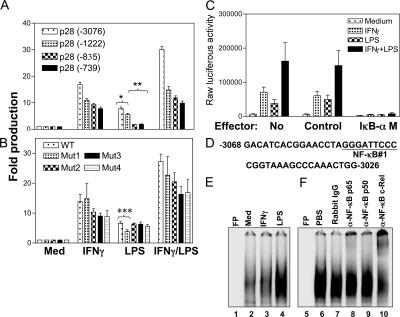Figure 6.
LPS response of p28 promoter constructs. (A) The −3,076/+129 and various 5′ truncation constructs of the mouse p28 promoter-luciferase reporter were transiently transfected into RAW264.7 cells by electroporation and the transfected cells were treated with 10 ng/ml IFN-γ, 1 μg/ml LPS, or IFN-γ plus LPS for 7 h. Luciferase activity from each construct was measured from cell lysates and normalized to the activity obtained with the untreated condition as relative activities (fold induction). Results shown are mean plus SE of six independent experiments. (B) RAW264.7 cells were transiently transfected with WT and the four putative NF-κB–RE mutant p28 promoter constructs. Transfected cells were treated with IFN-γ, LPS, or IFN-γ plus LPS for 7 h. Luciferase activity was measured from the cell lyses and normalized to the activity of medium alone as relative activities (fold induction). Data represent the mean ± SE from six independent experiments. *, P < 0.05; **, P < 0.001; ***, P < 0.0001, comparing between indicated groups. (C) RAW264.7 cells were transiently cotransfected with the p28 (−3,076/+129) promoter and IκB-α mutant or its control vector at a 1:1 molar ratio. Cells were treated by IFN-γ, LPS, and LPS plus IFN-γ for 7 h. Luciferase activity was measured from cell lysates. (D) The sequence of EMSA probe with the #1 predicted NF-κB–RE underlined. (E) Nuclear extracts were isolated from RAW264.7 cells after IFN-γ or LPS stimulation for 2 h. EMSA was performed with 17 μg of nuclear extract for each sample and a double-stranded oligonucleotide probe containing the −3,068/−3,026 region of the mouse p28 promoter. (F) A “supershift” EMSA was performed with the same probe and nuclear extracts from LPS-treated RAW264.7 cells. Three NF-κB–related antibodies and their control rabbit IgG were used (2 μg/lane).

